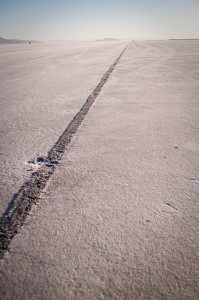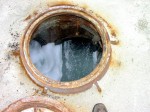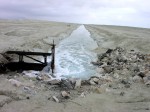Save The Salt: Preserving a Legendary Race Track
Bonneville Salt Flats: “Save the Salt”
 With all the Bonneville Salt Flats racing coverage and stories from MyRideisMe.com, maybe the most important story is the behind the scenes one, which is the “Save the Salt” program. Please follow along as Larry Volk (Chairman of the Board) and the Save the Salt Board Members provide a history of the Save the Salt Program and how important it is to the future of Land Speed Racing at Bonneville.
With all the Bonneville Salt Flats racing coverage and stories from MyRideisMe.com, maybe the most important story is the behind the scenes one, which is the “Save the Salt” program. Please follow along as Larry Volk (Chairman of the Board) and the Save the Salt Board Members provide a history of the Save the Salt Program and how important it is to the future of Land Speed Racing at Bonneville.
What is Save the Salt?
It has come to our attention that there are a number of folks out there that are not fully aware of what our Save the Salt organization is all about. To that end we have comprised the following brief history of when and why Save the Salt was formed. We hope this tells the story “In a Nutshell”.
Thanks to Mary West (Secretary of Save The Salt) for putting this history together and thanks to JoAnn Carlson (SCTA/BNI Office) for forwarding the note to us from a gentleman who is a new competitor at Bonneville. He said that he knew Save the Salt was important but he wondered what it was. By the way, he sent a donation along with his inquiry.
Save The Salt, a brief history:
During the (1930-1940) era the Bonneville Salt Flats was able to support the weight of 10-ton twin-engine streamliners that roared down the 13.5-mile long Race Courses. The Hot Rods roared onto the salt flats in 1949 with the first Speed Week event and have run every year since. Of course a few years were missed due to weather.
By the early 1960’s the pioneers of Land Speed Racing began to notice subtle changes in the surface of the raceway. There were discussions of why the surface seemed to be getting weaker and that this unique body of land was shrinking. We were able to get only as much as 7 miles of decent salt for our courses, if we were lucky. It wasn’t long before fingers were pointed at the mining industry on the south side of interstate 80. Owned by Kaiser Chemical, their operations covered some 50 sq. miles of the salt flats.
Rick Vesco, our first chairman of Save The Salt, spearheaded the effort to meet with Utah State and Federal Government officials as well as the Chemical Company to resolve the problem of salt depletion.
The goal was to return the salt that was accumulating in their settling ponds at the mining facility to the Raceway. These early cries for help continued until 1989 when the Save the Salt Organization was founded and struggled to achieve recognition as they began to see the heavy toll the mining industry was taking on the salt flats. In the meantime Kaiser Chemical had sold the operation to Reilly Chemical and a new 20-year lease for mining had been signed.
The once healthy 18 plus inches of salt had become so fragile that the Race Courses had to be moved farther and farther east. Running on the long International Race Course was no longer possible.
Reilly Industries was forcing water through canals crisscrossing the flats into their evaporation ponds from which potash was extracted. It was estimated that the process was taking an estimated 850,000 tons of salt from the flats each year.
The Save the Salt Board has members from the Southern California Timing Assn (SCTA) / Bonneville Nationals Inc (BNI). and Utah Salt Flats Racers Assn (USFRA). This group was able to negotiate a restoration agreement in 1997. Working hand in hand with the Bureau of Land Management (BLM) and Reilly Chemical Co. they began to work together to return salt from the ponds.
The Lay down Project was to reverse the process by pumping brine water back onto the salt flats at the rate of 1.5 million tons of salt each year for 5 years. The BLM, Reilly Chemical and the Racers embraced the plan. It was a giant step forward with Government and Industry working together.
From the beginning of the pumping project racers began to notice changes in the surface. By the end of the 5-year pumping plan the racers were able to get back to running on the old International Course.
Though not as long, there was a noticeable difference in the hardness and durability of the racecourses and on a few occasions we were able to get as much as an 11 mile course.
Once again the Potash Plant has been sold. Intrepid Industries is now the owner and has shown an interest in our quest to have a healthy Bonneville Salt Flats and a strong racecourse surface. They showed their support by once again starting the pumping process the first of February 2005.
We commend them for their efforts. The Save the Salt Board is committed to working with both the BLM and Intrepid Industries. While there is still a lot more to be done, our vigilance appears to have paid off, not just for the racing competitors but also by preserving this historical natural treasure, The Bonneville Salt Flats, for future generations to come.
Latest Update:
I made a trip to Intrepid Thurs. Feb 26th to see just how well the pumping was doing, talked to Russ Draper he told me that they started the pumping on Mon 2/23/09. As of Wed 2/26 they had pumped 25,000 tons of salt on to the flats. The brackish water that is being pumped has 23% salt, this is about the maximum that the pumps can handle.
Russ indicated to me that because of the trouble they encountered with the brackish well pump, they would not be able to pump as much as they would like to because they will need to start their production, he said he will keep us informed as to how much they are able to pump.
I took some pictures for every one to put on their websites.
Thanks: Larry
Anyone wishing to contribute to the Save the Salt fund may do so by mailing to:
Save The Salt
Russ Eyres
3673 Millikin Ave.
San Diego, Ca. 92122
Technical Advisors: Rick Vesco, Bonner Denton, Gordon Hoyt, Duane McKinney
Save The Salt Board:
Chairman: Larry Volk
Secretary: Mary West
Treasure: Mike Waters
BNI, Roy Creel
SCTA, Mike Cook
USFRA, Gary Allen










Great story Hechtspeed! Can you explain what’s in those pictures at the bottom?
Those pics at the bottom are of the pumps pumping a water/salt combination back onto the salt flats, per the agreement with the Save the Salt committee.
a piece of motoring history deserves preserving